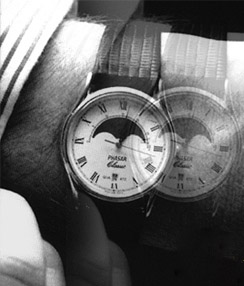Diplopia

Editor-In-Chief: Prab R Tumpati, MD
Obesity, Sleep & Internal medicine
Founder, WikiMD Wellnesspedia &
W8MD's medical weight loss NYC, sleep center NYC
Philadelphia medical weight loss and Philadelphia sleep clinics
| Diplopia | |
|---|---|

| |
| Synonyms | Double vision |
| Pronounce | N/A |
| Specialty | N/A |
| Symptoms | Seeing two images of a single object |
| Complications | Strabismus, Amblyopia |
| Onset | Can be sudden or gradual |
| Duration | Varies depending on cause |
| Types | N/A |
| Causes | Refractive error, Cataract, Cranial nerve palsy, Graves' disease, Myasthenia gravis, Stroke, Trauma |
| Risks | Diabetes, Hypertension, Multiple sclerosis, Thyroid disease |
| Diagnosis | Eye examination, Neurological examination, Imaging studies |
| Differential diagnosis | Monocular diplopia, Binocular diplopia, Migraine, Vertigo |
| Prevention | N/A |
| Treatment | Corrective lenses, Prism glasses, Surgery, Botulinum toxin |
| Medication | Corticosteroids, Antibiotics (if infection is present) |
| Prognosis | N/A |
| Frequency | Common |
| Deaths | N/A |
Diplopia, commonly known as double vision, is a condition where a person perceives two images of a single object. This can occur in one eye (monocular diplopia) or both eyes (binocular diplopia). Diplopia can be a symptom of various underlying conditions, ranging from benign to serious.
Causes[edit]
Diplopia can be caused by a variety of factors, including:
- Refractive errors: Imperfections in the eye's focusing ability can lead to monocular diplopia.
- Strabismus: Misalignment of the eyes can cause binocular diplopia.
- Cranial nerve palsies: Damage to the nerves controlling eye muscles can result in diplopia.
- Cataracts: Clouding of the eye's lens can cause monocular diplopia.
- Corneal irregularities: Conditions like keratoconus can lead to distorted vision.
- Neurological disorders: Conditions such as multiple sclerosis or myasthenia gravis can affect eye movement and alignment.
Symptoms[edit]
The primary symptom of diplopia is seeing two images of a single object. These images may be:
- Horizontally aligned
- Vertically aligned
- Diagonally aligned
Other symptoms that may accompany diplopia include:
Diagnosis[edit]
Diagnosing diplopia involves a comprehensive eye examination. An ophthalmologist or optometrist may perform tests such as:
- Visual acuity test
- Eye alignment and movement tests
- Slit-lamp examination
- Retinal examination
Treatment[edit]
Treatment for diplopia depends on the underlying cause. Options may include:
- Corrective lenses: Glasses or contact lenses can correct refractive errors.
- Prisms: Special lenses that help align the images seen by each eye.
- Surgery: Procedures to correct eye muscle alignment or remove cataracts.
- Medication: To treat underlying conditions like myasthenia gravis.
See also[edit]
Ad. Transform your life with W8MD's Budget GLP-1 injections from $75


W8MD offers a medical weight loss program to lose weight in Philadelphia. Our physician-supervised medical weight loss provides:
- Weight loss injections in NYC (generic and brand names):
- Zepbound / Mounjaro, Wegovy / Ozempic, Saxenda
- Most insurances accepted or discounted self-pay rates. We will obtain insurance prior authorizations if needed.
- Generic GLP1 weight loss injections from $75 for the starting dose.
- Also offer prescription weight loss medications including Phentermine, Qsymia, Diethylpropion, Contrave etc.
NYC weight loss doctor appointmentsNYC weight loss doctor appointments
Start your NYC weight loss journey today at our NYC medical weight loss and Philadelphia medical weight loss clinics.
- Call 718-946-5500 to lose weight in NYC or for medical weight loss in Philadelphia 215-676-2334.
- Tags:NYC medical weight loss, Philadelphia lose weight Zepbound NYC, Budget GLP1 weight loss injections, Wegovy Philadelphia, Wegovy NYC, Philadelphia medical weight loss, Brookly weight loss and Wegovy NYC
|
WikiMD's Wellness Encyclopedia |
| Let Food Be Thy Medicine Medicine Thy Food - Hippocrates |
Medical Disclaimer: WikiMD is not a substitute for professional medical advice. The information on WikiMD is provided as an information resource only, may be incorrect, outdated or misleading, and is not to be used or relied on for any diagnostic or treatment purposes. Please consult your health care provider before making any healthcare decisions or for guidance about a specific medical condition. WikiMD expressly disclaims responsibility, and shall have no liability, for any damages, loss, injury, or liability whatsoever suffered as a result of your reliance on the information contained in this site. By visiting this site you agree to the foregoing terms and conditions, which may from time to time be changed or supplemented by WikiMD. If you do not agree to the foregoing terms and conditions, you should not enter or use this site. See full disclaimer.
Credits:Most images are courtesy of Wikimedia commons, and templates, categories Wikipedia, licensed under CC BY SA or similar.
Translate this page: - East Asian
中文,
日本,
한국어,
South Asian
हिन्दी,
தமிழ்,
తెలుగు,
Urdu,
ಕನ್ನಡ,
Southeast Asian
Indonesian,
Vietnamese,
Thai,
မြန်မာဘာသာ,
বাংলা
European
español,
Deutsch,
français,
Greek,
português do Brasil,
polski,
română,
русский,
Nederlands,
norsk,
svenska,
suomi,
Italian
Middle Eastern & African
عربى,
Turkish,
Persian,
Hebrew,
Afrikaans,
isiZulu,
Kiswahili,
Other
Bulgarian,
Hungarian,
Czech,
Swedish,
മലയാളം,
मराठी,
ਪੰਜਾਬੀ,
ગુજરાતી,
Portuguese,
Ukrainian